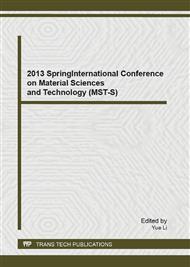[1]
K. Zekentes and K. Rogdakis, SiC nanowires: material and devices, Journal of Physics D: Applied Physics.44 (2011) 133001-(17).
DOI: 10.1088/0022-3727/44/13/133001
Google Scholar
[2]
J. C. Johnson, H. J. Choi, K. P. Knutsen, R. D. Schaller, P. Yang and R. J. Saykally, Single Gallium nitride nanowire lasers, nature materials.1 (2002) 106-110.
DOI: 10.1038/nmat728
Google Scholar
[3]
E. W. Wong, P. E. Sheehan and C. M. Lieber, Nanobeam mechanisms: elas- ticity, strength and toughness of nanorods and nanotubes, Science.277 (1997) 1971-1975.
DOI: 10.1126/science.277.5334.1971
Google Scholar
[4]
Z. W. Pan, H. L. Lai, C. K. Frederick, X. F. Duan, W. Y. Zhou, W. S. Shi, N. Wang, C. S. Lee, N. B. Wong, S. T. Lee and S. S. Xie, Oriented silicon carbide nanowires: synthesis and field emission properties, Adv. Mater.12 (2000) 1186-1190.
DOI: 10.1002/1521-4095(200008)12:16<1186::aid-adma1186>3.0.co;2-f
Google Scholar
[5]
T. Seeger, P. Kohler-Redlich and M. Ruhle, Synthesis of Nanometer-Sized SiC Whiskers in the Arc-Discharge, Adv.Mater.12 (2000) 279-282.
DOI: 10.1002/(sici)1521-4095(200002)12:4<279::aid-adma279>3.0.co;2-1
Google Scholar
[6]
R. B. Wu, B. S. Li, M. X. Gao, J. J. Chen, Q. M. Zhu and Y. Pan, Tuning the morphologies of SiC nanowires via the control of growth temperature, and their photoluminescence properties Nanotechnology.19 (2008) 335602-(8).
DOI: 10.1088/0957-4484/19/33/335602
Google Scholar
[7]
F. K. Cai, A. X. Zhang, J. L. Yin, H. F. Wang and X. H. Yuan, Preparation, characterization and photoluminescence properties of ultra long SiC/SiOx nanocables, Applied Physics A.91 (2008) 579-584.
DOI: 10.1007/s00339-008-4495-1
Google Scholar
[8]
G. Li, X. Li, Z. Chen, J. Wang, H. Wang and R. Che, Large Areas of Centimeters-Long SiC Nanowires Synthesized by Pyrolysis of a Polymer Precursor by a CVD Route, J. Phys. Chem. C.113 (2009) 17655-17660.
DOI: 10.1021/jp904277f
Google Scholar
[9]
K. Rogdakis, S. Lee, M. Bescond, S. Lee, E. Bano and K. Zekentes, 3C-Silicon Carbide Nanowire FET: An Experimental and Theoretical Approach, IEEE Transactions on Electron Devices.55 (2008) 1970-1976.
DOI: 10.1109/ted.2008.926667
Google Scholar
[10]
H. Seong, H. Choi, S. Lee, J. Lee and D. Choi, Optical and electrical transport properties in silicon carbide nanowires, Applied Physics Letters.85 (2004) 1256-1258.
DOI: 10.1063/1.1781749
Google Scholar
[11]
H. K. Seong, H. J. Choi, S. K. Lee, J. I. Lee and D. J. choi, Fabrication and electrical transport properties of CVD grown silicon carbide nanowires for field effect transistor, Mater. Sci.Forum.527-529 (2006) 771-774.
DOI: 10.4028/www.scientific.net/msf.527-529.771
Google Scholar
[12]
W. M. Zhou, X.Liu and Y.Zhang, Field-effect transistor based on β-SiC nanowire FET, IEEE Transactions on Electron Devices Lett.27 (2006) 463-466.
Google Scholar
[13]
W. Zhou, X. Liu and Y.Zhang, Simple approach to β-SiC nanowires: Synthesis, optical, and electrical properties, Appl. Phys. Lett.89 (2006) 223124-223121-223124-3.
Google Scholar
[14]
G. Peng, Y. Zhou, Y. He, X. Yu and G. Li, Fabrication and properties of ultraviolet photo-detectors based on SiC nanowires, Science China.55 (2012) 1168-1171.
DOI: 10.1007/s11433-012-4790-x
Google Scholar
[15]
W. Gotz, N. M. Johnson, C. Chen, H. Liu, C. Kuo and W. Imler, Activation energies of Si donors in GaN Appl. Phys. Lett.68 (1996) 3144-3146.
DOI: 10.1063/1.115805
Google Scholar
[16]
E. H. Rhoderick and R. H. Williams (1988). Metal-semicaonductor contact, Oxford.
Google Scholar
[17]
S. M. Sze (1981). Physics of Semiconductor Devices. New York.
Google Scholar
[18]
L. Kolaklieva and R. Kakanakov (2009). Ohmic contacts for High Power and Hagh Temperature Microelectronics. Bulgaria, Bulgarian Academy of Science.
DOI: 10.5772/7017
Google Scholar
[19]
K. Huang, Q. Zhang, F. Yang and D. He, Ultraviolet Photoconductance of a Single hexagonal WO3 Nanowire, Nano Res.3 (2010) 281-287.
DOI: 10.1007/s12274-010-1031-3
Google Scholar


